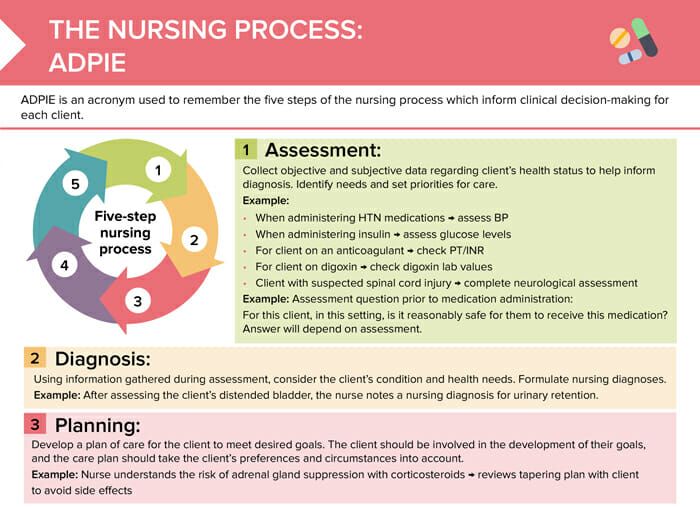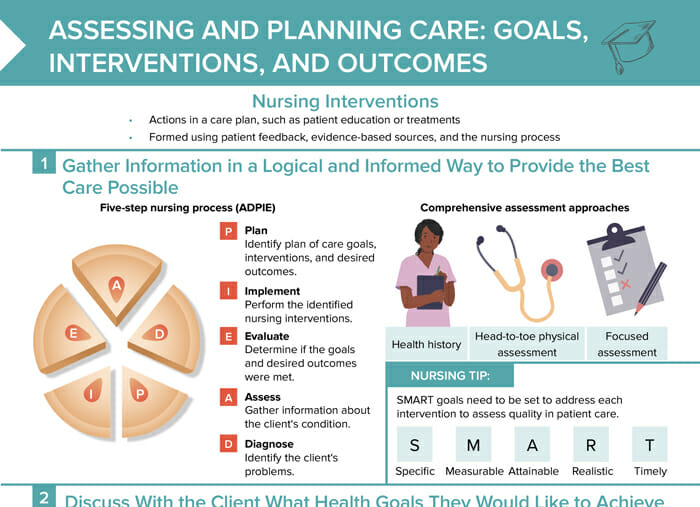What is a nursing care plan?
A nursing care plan is a written document detailing the nursing interventions that will be done to meet a client’s needs and health goals. It serves as a guide for personalized care of the client and facilitates communication in the healthcare team.
What is a nursing intervention?
Nursing interventions are actions in a care plan, such as patient education or treatments. They are formed using patient feedback, evidence-based sources, and the nursing process.
How to write a nursing care plan
How to prepare a nursing care plan using the 5-step nursing process (ADPIE):
- Assess
- Diagnose
- Plan
- Implement
- Evaluate
Following the nursing diagnoses that were formed based on a thorough assessment (history, physical assessment, focused assessment), a clear plan of care goals, interventions, and desired outcomes is defined.
Nursing tip: Gather information in a logical and informed way to provide the best care possible.
Nursing tip: To address each intervention to assess quality in patient care, goals need to be SMART:
- Specific
- Measurable
- Attainable
- Realistic
- Timely
Discuss with your client which health goals they would like to achieve.
Nursing care plan template & examples
Once the client’s goals are established, nursing interventions (NIC) and standard nursing outcomes (NOC) can be used to guide patient care.
They can, for example, be presented in the nursing care plan in a column-based format:
| Goals | Nursing interventions | Nursing outcomes |
| Health goal of the client | Action that is taken to reach the goal | Result of the intervention in respect to the goal |
Examples of goals could be:
- Stage 1 pressure ulcer will resolve
- Client demonstrates insulin injection procedure
- Client reports pain level < 4 with ambulation
Examples of fitting nursing interventions could be:
- Reposition client every 2 hours
- Request diabetes education consult
- Administer pain medication 1 hour before physical therapy
Examples of possible outcomes could be:
- Reduced redness in lower back area
- Client demonstrates self-injection techniques
- Client ambulates 100 feet twice a day
Nursing intervention examples (practice questions)
Which nursing intervention is placed in the plan of care for a client diagnosed with osteoarthritis?
Answer options:
- Apply a cold compress to the affected joint for 15–20 minutes
- Encourage high-impact exercise like jogging
- Administer IV antibiotics as prescribed
- Start a weight-lifting program for strength
Correct answer:
- Applying a cold compress to the affected joint for 15–20 minutes.
Explanation:
Cold compresses can help reduce inflammation and relieve pain in osteoarthritis. High-impact exercise and lifting weights can worsen the condition, and antibiotics are not used for osteoarthritis, as it’s not caused by an infection.
A client is diagnosed with hypervolemia. Which is the priority nursing intervention?
Answer options:
- Encourage fluid intake hourly
- Monitor weight and strict I & O
- Administer bronchodilators
- Initiate cardiac monitoring
Correct answer:
2. Monitor weight and intake and output carefully.
Explanation:
In hypervolemia, fluid overload is a concern. Monitoring weight and intake and output allows for accurate assessment and helps guide treatment. More fluid intake would exacerbate the problem, and bronchodilators are not directly related to fluid volume management. Cardiac monitoring is not required as no cardiac problem is identified.
A client has completed a bone marrow biopsy. Which nursing intervention is the priority action post-procedure?
Answer options:
- Elevate the extremity where the biopsy was taken
- Administer a dose of intravenous antibiotics
- Apply pressure to the biopsy site
- Use heating pad at site on low setting
Correct answer:
3. Apply pressure to the biopsy site.
Explanation:
Applying pressure to the biopsy site helps prevent hemorrhage and facilitates clot formation. Elevating the extremity and administering antibiotics are not generally the priority interventions post-bone marrow biopsy. Ice packs, not heat, can be used for short periods of time for tenderness.
Which nursing intervention is essential in caring for a client diagnosed with compartment syndrome?
Answer options:
- Apply ice to the affected extremity.
- Elevate the affected limb above heart level.
- Loosen or remove the tight bandage or cast.
- Alert the Rapid Response Team.
Correct answer:
3. Loosen or remove the tight bandage or cast.
Explanation:
Compartment syndrome is caused by increased pressure within a muscle compartment, which can compromise circulation to the area. If a tight bandage or cast is contributing to the pressure, it should be loosened or removed to alleviate the pressure. The other answers could potentially worsen the condition. The Rapid Response Team is notified for imminent deterioration, which this client is not manifesting
The nurse cares for a client diagnosed with pyelonephritis. Which nursing intervention does the nurse include in the plan of care?
Answer options:
- Encourage fluid restriction.
- Administer prescribed antibiotics.
- Apply a heating pad to the lower back.
- Instruct client to keep blood glucose lower.
Correct answer:
2. Administer prescribed antibiotics.
Explanation:
Pyelonephritis is a bacterial infection of the kidneys that usually requires antibiotic treatment for resolution. Fluid restriction is generally not recommended; in fact, increased fluids may be encouraged. A heating pad may provide temporary relief but doesn’t treat the underlying infection. If the client does have diabetes mellitus, it does increase the risk for pyelonephritis, but no mention of this is given.

